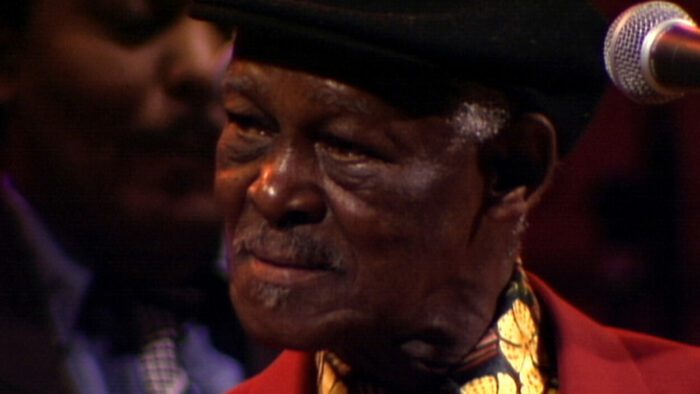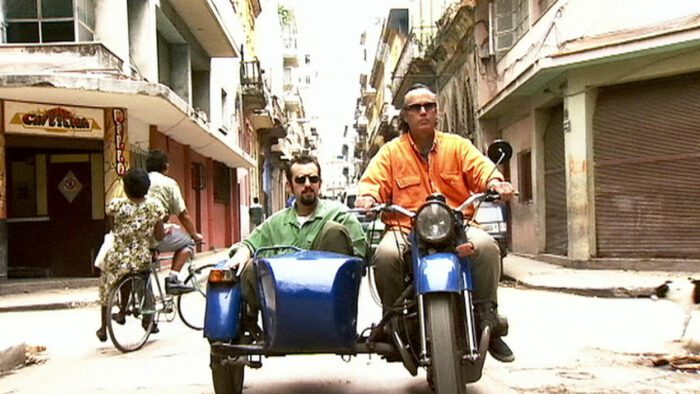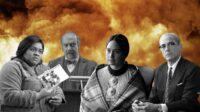Wim Wenders’ mesmerizing documentary Buena Vista Social Club premiered at the Berlin Film Festival in 1999. After 25 years I’m trying to recollect my memories of and around this film. Because they are so fragmented and spread over the years, writing this piece feels like collecting puzzle pieces you initially hadn’t even realized belonged together.
My first memory is the song “Chan Chan” which would often come up on the radio. I found out only later that it was the opening track of the Grammy-awarded album Buena Vista Social Club which was released in 1996. The voices I heard were of Compay Segundo, also the author of the song, and Eliades Ochoa. I heard the other songs probably around that time too. I didn’t know the story behind the album. Neither did I know anything about the singers. It was a pre-internet era with much less access to information, and I lived in the post-Soviet country of Georgia where information usually came with a delay.
“Veinte Años,” performed by Omara Portuondo and Compay Segundo, was the second song of the album I fell in love with. I even learned the lyrics and chords and used to play it on my guitar. Then I got to know Ibrahim Ferrer. My interest was focused on singers first. It was much later that I paid due attention to the pianist Ruben Gonzalez who became one of my favorites. But I think the first time I put faces to the voices was when I saw the video for the same song—“Chan Chan,” consisting of the images from the documentary. And then at some point, I saw the film.

I wanted to write these boring details because this is how I experienced what I’m writing about now. It was, basically, a chaotic mix of experiences and unconnected events, randomly scattered over a few years.
Living in Georgia in the 1990s was, in fact, not much different from the lives of people we see in the streets of Havana in Wenders’ documentary. It may sound exaggerated to say that, for me, this music was bringing some light in the darkness, but it kind of was. Because it was one of those little things that do not seem important but make you feel alive in an otherwise bleak world, even if you don’t realize it at the moment.
As someone from another small country with its authentic culture and going through hardly the best times, I could relate more to Cubans than to the film crew or producers. Especially, considering that it was the 1990s, a few years after the Soviet Union ended and the socialist countries ended up in economic collapse. Cuba was one of them. Although the film is not focused on politics, but rather on the lives of the people we see on the screen, I believe it was probably impossible to avoid it entirely while filming in Cuba.
Later we see the musicians stroll in the streets of New York, before their Carnegie Hall concert, window shopping, amazed by the skyscrapers and bustling streets. So much contrast with the views of Havana. You can’t help but think of the irony of the fact that the musicians from the Island of Freedom were hardly able to visit and give a concert in the freest country that has the Statue of Freedom as one of its symbols.
Buena Vista Social Club, not the album or the film or the band, but the club that existed from the 1940s till the early 1960s, apparently being an important part of the musical life of Havana, and which inspired the band’s name, was a ‘victim’ of the political changes introduced by the revolutionary government after 1959. It was closed in the early ’60s. Musicians’ lives changed. I don’t know the details, but judging from how things were in my country, I can assume that things were very different from the music industry in Europe or the USA.
So, despite trying to avoid a delicate topic, the political layer is still noticeable everywhere. Though Wenders manages to move it to the background—as he usually does, in my opinion. His films go beyond any political discourse. It is something that affects lives but still, his focus is on humans, the lives of his characters. They are ultimately about people who live in different societies governed by different rules but in the end, these are ordinary people trying to live their lives. In this regard, I can’t avoid mentioning Wenders’ last film, Perfect Days. Though the context is very different, Perfect Days echoes Buena Vista Social Club in so many ways.
As it is revealed in the film, the whole thing with the album started when Nick Gold from World Circuit Records offered Ry Cooder to go to Cuba to record local musicians. The result was the randomly organized band Buena Vista Social Club which consisted of the old-school Cuban musicians they were able to find, who were still alive. Through Ry Cooder, Wim Wenders got involved after listening to the raw recorded material. Based on how he recalls it in the interviews, the music had a similar effect on him to what it had on me.

Wenders shot the recording sessions, interviews with the musicians, and later the concerts in Amsterdam and Carnegie Hall—capturing the moments of the success they never imagined achieving. They were almost forgotten by that time, even in their country. As it usually happens, old music was replaced by more modern music. And they were mostly unknown to the world. Many of them were in their 70s, 80s and even 90s. Ibrahim Ferrer was not singing anymore, doing whatever work he could find. Ruben Gonzalez didn’t even own a piano.
As it often happens, it took outsiders to get them out in the light and revive that forgotten music. In Buena Vista Social Club, Wenders´ camera witnesses the meeting of two worlds. Ry Cooder’s electric guitar, which by itself represents modern technologies in music, gives the music on the album a specific, very distinguishable sound. Perhaps this blend is the best example that shows the abovementioned connection between the worlds.
There is one more thing in the film that I have often thought about when reflecting on the Soviet past of my country. When you look at the streets of Havana in the film, the old rusty cars, the small and poor flats where these people live, or the old-fashioned recording studio, it makes you think that time has stopped in this place. But then another thought comes to mind. Would the musicians like these exist in a different environment? Maybe that stillness is what made it possible to preserve them and their music. Because there is something timeless in it.
The film contains interviews with all the members of the band. They tell their personal stories, often filled with hardships and sadness. The still time is felt in these stories as well. They sound like fairy tales or legends from distant times, like they happened in another life.
Producers and the film crew represent a different world and perspective. They are from countries with developed economies, but perhaps exactly for this reason lacking connection with the more ancient and natural side of life. This is why this music immediately gained so much attention and popularity worldwide. Perhaps it was what teenage me living in bleak post-Soviet Georgia needed. Seeing the film after 25 years, in different times and conditions, and equipped with more life experience, I realized that my present self needed it as well.
I love watching close-ups on Ry Cooder. Apart from being amazed by the mastery of these musicians, I believe, there is more than that. His face expresses the realization that he is in touch with something out of the ordinary, and at the same time as ordinary as it gets. It is that ancient, or timeless spirit coming from people who are in their 70s, 80s, and even 90s. Are they perfect? No. Or are their voices perfect and never miss a note? Well, with some exceptions, no. But who cares? Because it all comes from somewhere beyond them.
Their artistic personalities are the same on the stage as in their lives. This music is their life. 80-year-old Ruben Gonzales plays masterfully with or despite his arthritic hands, and it is something you could hardly imagine to be possible. Perhaps, at their age, they can afford it to deliver something that is bigger than life, without getting in its way. It sounds like a cliché but isn’t it a role and purpose of any artist to be a vessel for something bigger than themselves, whatever you call it, and make it possible for that something to pour out through them? Well, if it is, these people show us how you do it.



